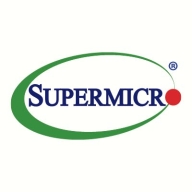

PowerEdge C and Supermicro SuperBlade compete in the server hardware market, each offering unique advantages. PowerEdge C tends to outperform in feature metrics, while Supermicro SuperBlade offers superior overall value through feature-rich options.
Features: PowerEdge C is recognized for robust scalability with high-density compute nodes and efficient power management. It also includes high CPU processing power and the iDRAC feature for streamlined remote management. Supermicro SuperBlade is noted for its wide variety of blade configurations, support for high-performance computing, and compact form factor conducive to customized deployments.
Room for Improvement: PowerEdge C could enhance feature variety and adaptability to high-performance applications. Users might benefit from improved personalization and configuration options. Meanwhile, Supermicro SuperBlade may consider simplifying initial setup processes and controlling costs for budget-sensitive buyers. Increasing straightforward guidance in deployment would also add value.
Ease of Deployment and Customer Service: PowerEdge C offers straightforward deployment processes, clear guides, and efficient customer support, facilitating server setup. Supermicro SuperBlade focuses on personalized configuration and extensive deployment options, requiring more initial setup effort but providing tailored solutions, ideal for businesses needing specialized configurations.
Pricing and ROI: PowerEdge C typically incurs a lower initial setup cost, appealing to budget-conscious buyers. Supermicro SuperBlade, although potentially higher in upfront cost, offers optimized configurations promising better ROI in advanced compute environments, making it attractive for meeting specific long-term business needs.


PowerEdge C help you to maximize hyperscale performance with up to 4 independent server nodes, flexible storage and shared infrastructure in a compact 2U chassis.
Supermicro SuperBlade delivers innovative computing performance and efficiency, perfect for data-intensive tasks. With its modular design, it optimizes space and power, providing a flexible and scalable infrastructure for demanding business workloads.
Supermicro SuperBlade is specifically engineered for modern data centers needing high-density computing. It offers a compact, modular architecture that simplifies system management and enhances agility. It integrates seamlessly with cloud and virtualization technologies, supporting diverse applications and workloads. Its design focuses on reducing operational costs while achieving peak performance. Users appreciate its balance of power efficiency and high computing capacity.
What are the key features of Supermicro SuperBlade?Supermicro SuperBlade is widely implemented in sectors such as finance, healthcare, and research where high computational power and storage are critical. In finance, it's used for real-time analytics and transactions. Healthcare facilities use it for patient data analysis and complex simulations, while research institutions leverage SuperBlade for simulations and data-intensive research tasks. Its adaptability allows enterprises to efficiently meet technical requirements unique to each industry.
We monitor all Blade Servers reviews to prevent fraudulent reviews and keep review quality high. We do not post reviews by company employees or direct competitors. We validate each review for authenticity via cross-reference with LinkedIn, and personal follow-up with the reviewer when necessary.